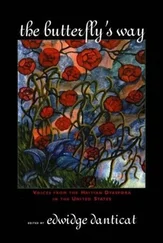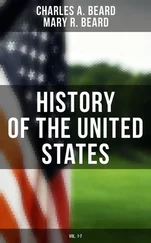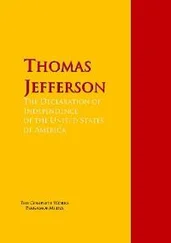The 1870s, 1880s, and 1890s witnessed some of the bloodiest labor struggles in the nation’s history. In 1877, striking railroad workers and their myriad supporters from all parts of the working class paralyzed much of the nation’s rail traffic as capitalists, haunted by memories of the revolutionary workers who created the Paris Commune of 1871, conjured up their own nightmare visions when several cities, including Chicago and St. Louis, were shut down by general strikes. In Washington, D.C., the National Republican newspaper ran an editorial titled “The American Commune,” which stated, “The fact is clearly manifest that communistic ideas are very widely entertained in America by the workmen employed in mines and factories and by the railroads.” The railroad strike “is nothing less than communism in its worst form, not only unlawful and revolutionary, but anti-American.” 23St. Louis’s leading newspaper, the Republican, concurred: “It is wrong to call this a strike; it is a labor revolution.” 24When local militias proved unwilling or unable to quell the uprising, President Rutherford B. Hayes, who owed his office in part to the railroad magnates, sent in the U.S. Army. The ensuing battles left over a hundred workers dead and a nation bitterly divided.
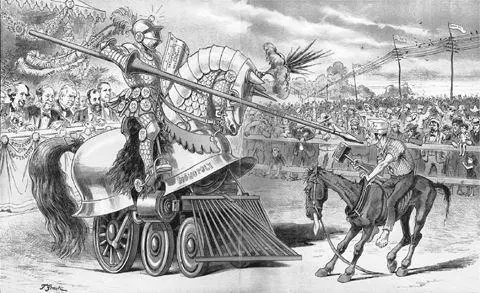
This August 1883 Puck magazine cartoon depicts the unequal late nineteenth-century battle between labor and monopolists. A number of robber barons are portrayed in the stands at left, including (from left to right) financier and telegraph innovator Cyrus Field, railroad magnate William Vanderbilt, shipbuilder John Roach, and railroad magnate Jay Gould.
The struggles intensified in the 1880s as the Knights of Labor exploded on the scene, successfully striking Jay Gould’s 15,000-mile railroad network in 1885. Gould was no ordinary robber baron. Having once boasted that he could “hire one half of the working class to kill the other half,” he was perhaps the most hated man in the nation. 25And the Knights, with their appeal to class unity and democratic socialist philosophy, was no ordinary labor federation. Gould’s capitulation to the Knights’ demands, in what the business newspaper Bradstreet’s called a “complete surrender,” shocked the nation. 26Knights membership skyrocketed around the country, jumping from 103,000 on July 1, 1885, to over 700,000 a year later. The movement was dealt a crushing blow, however, when authorities nationwide used the death of seven policemen in Chicago’s Haymarket Square in May 1886 as an excuse to not only destroy the anarchists, who were involved in the incident, but to go after the Knights, who forswore violence and were completely uninvolved in the Haymarket events. Radicals everywhere were targeted in the ensuing Red Scare.
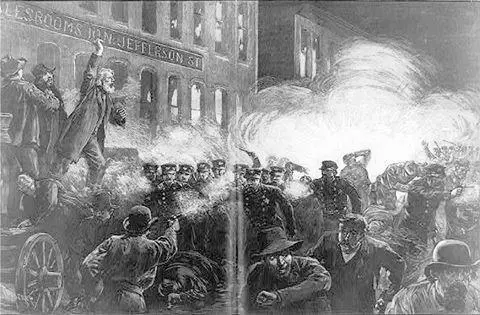
“Haymarket Riot,” May 4, 1886. Authorities used the death of policemen in Haymarket Square to crush not only the anarchists, who were involved in the incident, but also the Knights of Labor. Soon radicals across the nation were under attack.
Looking back on the period, reformer Ida Tarbell recalled that “the eighties dripped with blood.” 27Though the decade did not quite drip with blood, workers did question the legitimacy of a system that empowered the wealthy—the new corporate and banking elite—and marginalized the overwhelming majority of workers and farmers, who experienced limited advances in good times and often devastating setbacks in bad.
Discontent was regularly expressed by angry farmers as well, particularly the ones who organized the Farmers Alliances in the 1880s and the People’s Party in the early 1890s. Historians continue to debate just how radical farmers were, but there is no doubt that most opposed the growing reach of the corporate state, and many of their leaders roused audiences with anti–Wall Street rhetoric. The People’s Party adopted a platform at its first convention in Omaha, Nebraska, in 1892 that declared, “The fruits of the toil of millions are boldly stolen to build up colossal fortunes for a few, unprecedented in the history of mankind; and the possessors of these, in turn, despise the republic and endanger liberty. From the same prolific womb of governmental injustice we breed the two great classes—tramps and millionaires.” 28

Edward Bellamy, 1890. With much of the American middle class repulsed by the greed guiding the economy, Bellamy’s novel Looking Backward quickly sold over a million copies upon its publication in 1888. It also inspired the rise of Nationalist Clubs across America, hoping to help realize the author’s utopian socialist vision.
Although the Populists’ appeal was limited to parts of the South, Midwest, and West, the People’s Party won almost 9 percent of the presidential vote in 1892, carrying five midwestern and western states and electing over 1,500 candidates, including three governors, five senators, and ten congressmen. The Populists doubled their vote in 1894, electing seven congressmen and six senators.
Much of the middle class shared the revulsion toward an economy predicated upon the notion that individuals motivated by private greed would somehow produce a greater social good. Middle-class Americans not only sided with the railroad strikers in the Great Strike of 1877, they devoured Edward Bellamy’s enormously popular 1888 utopian socialist novel Looking Backward, which quickly sold over a million copies, making it the second most popular American novel of the nineteenth century, behind Harriet Beecher Stowe’s Uncle Tom’s Cabin .
The financial panic on Black Friday—May 5, 1893—triggered the nation’s worst depression to date. It would last five long years. Within months, 4 million workers lost their jobs. Unemployment soon approached 20 percent.
The nation debated the depression’s causes and sought ways to avoid future economic collapse. Those who believed that the 1893 depression resulted from overproduction argued that the United States needed more markets abroad to absorb its growing surplus. Socialists, trade unionists, and reformers, on the other hand, believed that the 1890s crisis resulted from under -consumption and proposed a different solution: redistributing wealth at home so that working people could afford to buy the products of America’s farms and factories. But few capitalists endorsed that approach, choosing instead to involve the United States in world affairs in ways that would fundamentally transform the nation.
Before the United States could stake its claim to foreign markets and natural resources, it needed a modern steam-powered navy and bases around the world to supply it. The United States annexed the harbor of the Pacific island of Pago Pago in 1889 and built a new navy between 1890 and 1896.
Pago Pago was just the start. In 1893, American sugar planters, working with the U.S. minister in Honolulu and supported by U.S. marines and sailors, toppled Hawaiian Queen Liliuokalani and installed American Sanford Dole, a cousin of pineapple magnate James Dole, as president. The United States annexed Hawaii in 1898. President William McKinley called it “Manifest Destiny.” 29
The United States declared war against Spain on April 25, 1898, purportedly to deliver Cuba from Spanish tyranny. The fighting began thousands of miles away in Manila Bay, where, on May 1, Commodore George Dewey destroyed the Spanish fleet. One anti-imperialist noted, “Dewey took Manila with the loss of one man—and all our institutions.” 30The war was over in three months.
Читать дальше





